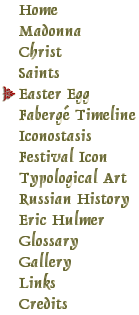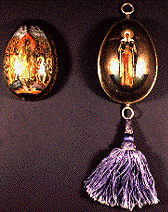

|

|
 click here to see a larger image Maker: Edward Wilhelm Schramm St. Petersburg, before 1897 Silver -mounted paper mache Hallmarks: E.S. in oval cartouche (mark of Edward Wilhelm Schramm); crossed anchors and scepter (mark of the city of St. Petersburg prior to 1897); 84 (silver fineness mark indicating the standard of 87.5% fine). On one side of the egg's exterior is depicted the Resurrection, in which Christ releases Adam and Eve from Hades (similar to western purgatory). This traditional image represents the Easter season in Russian Orthodox liturgy. On the other side is Saint Tatiana (223-235 A.D.), who lived her short life in Rome. When Emperor Alexander Severus discovered that her family was illegally practicing Christianity, he executed Tatiana's father immediately, but tortured the young girl in hopes of converting her to pagan ways and making an example of her. Tatiana's refusal to betray Christ led to her martyrdom. The egg itself opens to reveal a Russian inscription inside which might be translated: "From the Moscow Old Believers Who Are Receiving Blessing." The Old Believers came about when Patriarch Nikon reformed Russian Orthodoxy in the middle of the seventeenth century. After that time, those who continued to follow the old ways called themselves "the Old Believers." This egg was most likely a collective gift from the church community, perhaps a group preparing for ordination, to someone who held Tatiana as her personal name saint. The egg is an ancient symbol of life, hope, and joy. From early Christian times, it has stood for the Resurrection itself, and the promise of life after death. During the Easter season in Russia it was traditional to dye eggs red and pass them out to friends. Husbands and brothers would buy eggs for their daughters, wives, and mothers as gifts during the Lenten season. These eggs could also be secured by a ribbon to hang in one's home as a religious image, or could be worn around the neck. However, in general, eggs are not used as prayer icons, but serve as religious objets d'art. Easter eggs could be made out of paper mache, enamel, silver, or gold, depending upon the wealth of a family. The most famous are those made by Carl Fabergé for the imperial house. The first was commissioned in 1884 by Alexander III as a surprise for his wife, Maria Fydorovna, on Easter day. The ornate gift was so loved by Maria that Alexander commissioned 56 more eggs for the following years, although by his death only eight had been produced. His son continued the tradition, commissioning two a year, one for his mother and the other for his wife. Fabergé's creations were ingenious, ranging from large clocks in ovoid shapes to elaborately decorated eggs embedded with jewels, displaying the wealth of the Russian tsars. Contrary to popular belief, an item did not have to be made by Carl Fabergé himself to be considered a Fabergé. In reality, Carl Fabergé approved the item's design, at which point the actual construction of the object was delegated to one of his many workmasters. Our egg, although most likely produced in a Fabergé workshop, is considerably less ostentatious than the imperial eggs, though assuredly no less well made, even though its maker was a lesser known workmaster. See the Fabergé Time Line if you would like to know more about Fabergé. |
|
Home | Madonna | Saints | Christ | Easter Egg | Fabergé Timeline | Russian History | Eric Hulmer | Iconostasis | Festival Icon | Typological Art | Gallery | Glossary | Links | Credits
This page has been researched and created by Benjamin Allison, with additional research provided by the original exhibition catalog text by Christy Allbee. This egg has been tentatively attributed to the Fabergé workshop by Benjamin Allison. |